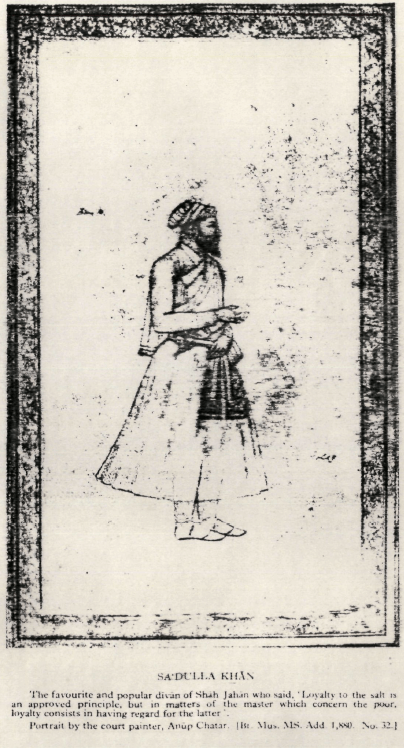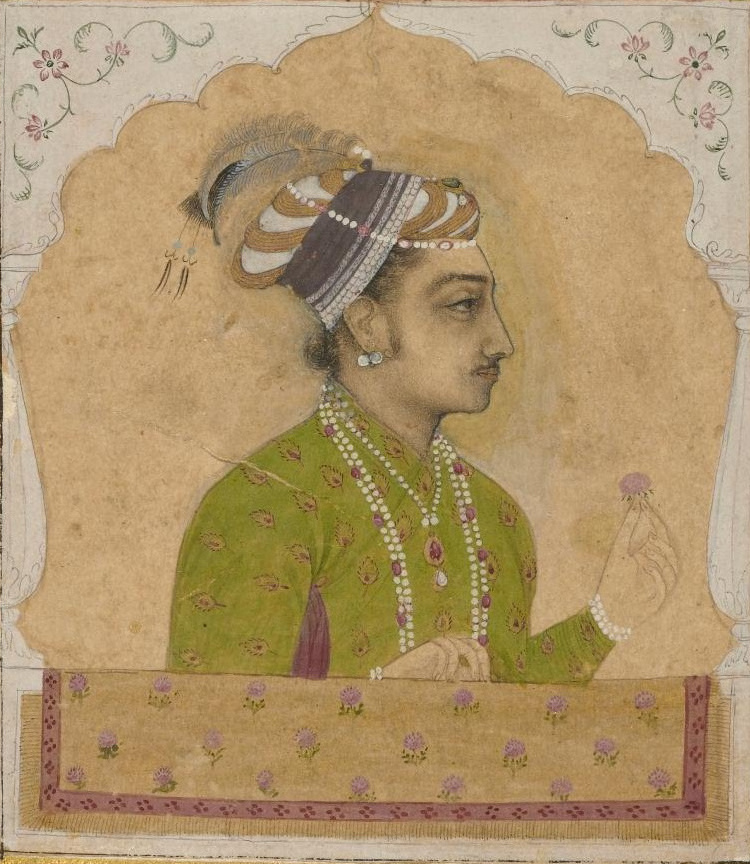
A project I work on from time to time is compiling a list of Punjabi Muslims in Mughal Nobility. I also previously wrote about Shahbaz Khan Kamboh. Recently I had the fortune of coming across another Punjabi Muslim standout who was in fact the Grand Vizier or Prime Minister of Mughal Empire for 10 years under Shah Jahan which is at a time Mughals were very much at their peak. What makes his appointment so special is that Mughal empire’s nobility was dominated by Turkic & Persian factions, naturally given that its rulers were from Central Asia, so it is remarkable for a Punjabi Muslim to rise to such high ranks.
Who was Sadullah Khan? One account claims his elders were settlers of Arab origin once upon a time, much like the poet Waris Shah, although Tahqiqat-E-Chishti claims he was a Jatt, but provides no source. Either ways the fact he is described as a Shaikhzada by Mughal accounts confirms his local roots. [2] French traveller Francois Bernier in his book Travels in Mogul Empire “Sadullah-Kan, who, from being an Indian by birth, had excited the jealousy of the Persians at court.” [6]
Shaikhzada was a term used for members of Mughal nobility of Indian i.e. native origin [4] & Sadullah being from Chiniot confirms he was a Punjabi given that the name of this land has been Panchanada for ages from Mahabharta (approx. 7000 years) to Al-Biruni’s (973-1048 AD) accounts & with Persianization we see a shift towards the word Punjab. Ibn Battuta in his 14th century account uses the word as “Bunjab” (Arabic) & later we see Ain-e-Akbari use Punjab.
Sadullah did not come from a distinguished background & his rise to the Vizarat was purely based on merit. The move from Chiniot to Lahore which was and still is a center of learning was to find distinguished teachers under whom he would dedicate himself studying both Islamic & worldly sciences.

Source: [a]
Career:
His imperial service begins as Examiner of Petitions after an interview with Shah Jahan who was on the hunt for efficient officers and gradually Sadullah Khan worked his way up to become Grand Vizier (Vazir-e-Azam) in 1645 at age 36, a post he would hold for ten years until his death.
In Ruka’at i Alamgiri, a collection of Aurangzeb’s letters we see him talk about the work ethic of the Vizier in a letter to his son, the crown prince Sultan Muhammad Muazzam (1643-1712) who later becomes Bahadur Shah 1 “Sa’ad Allah Khan depended upon ( the management of) Abdul Nabi, his secretary, and that the Khan himself spent his time zealously in the (discharge of) state affairs.” [7]. The two were also sent together by Shah Jahan to take Qandahar in two separate expeditions against the Persians which did not turn out favourable for the Empire, but Sadullah’s real expertise lie as an administrator. Francois Bernier in his accounts “Vizier Sadullah-Kan, a nobleman whom the Mogol (Mughal) considered the most accomplished statesman of Asia, and for whom he (Shah Jahan) felt a warmth of friendship” [6]. This is not to say he was a complete failure as a General as he was part of the successful Balkh expedition with Shah Jahan and putting down the rebellion of the Raja of Chittor (Rajastan), Rana Raj Singh. After Sadullah Khan demolished the fort walls, the Raja would send his son to Shah Jahan in order to beg for forgiveness and promising not to repeat his actions to which Shah Jahan would accept. [1].
Interestingly, Sadullah Khan was not the only Punjabi Muslim in Shah Jahan’s inner circle, Hakim Alimuddin or Wazir Khan was royal physician & Muhammad Saleh Kambo was author of Amal-i-Salih. In fact according to Zakhirat-ul-Khawanin, Wazir Khan who was Subedar of Punjab appointed Sadullah Khan as teacher at his Lahore madrassa given both were Punjabis from Chiniot. And as prominent nobleman both left landmarks fitting of their stature, the former Wazir Khan mosque in Lahore & Sadullah Khan, the Jama Masjid Delhi among others.
Death:
As Bernier’s account shows, Sadullah Khan was fairly close with Shah Jahan, the Emperor even visited the Grand Vizier in his last days. Shah Jahan upon hearing Sadullah Khan has passed away (7th April, 1656) due to colic was in tears. His eldest son Luftullah Khan was 11, but was granted a nobility rank of 1000 (400 cavalry) & everyone from his family to servants were given generous stipends or positions. [2]

The Italian traveller Niccolo Manucci describes Sadullah as “a man of great wisdom” & in his accounts holds Prince Dara Shikoh responsible albeit he labels it a rumour for the death of Sadullah Khan via poison due to his support for Prince Aurangzeb who of course became Emperor as we know it. [5] Francois Bernier also charges Dara Shikoh with Sadullah Khan’s murder, but according to him Dara’s reasons were that the Vizier would have used his influence to a) place Prince Shah Shuja b) help the Pashtuns since his wife was one c) or appropriate the throne for himself. [6] However, those are Francois’ opinions, but to be even associated with the rumour of taking the throne for himself shows us the stature of Sadullah Khan in the eyes of foreigners.
Sadullah Khan was also maternal grandfather to Qamar-ud-Din Khan or Nizam-ul-Mulk, the founder of Nizam of Deccan who founded the Hyderabad State. [3].
I will conclude this post with a quote from Sadullah Khan while talking to Emperor Shah Jahan himself ” The necessaries of the life of a man are in proportion to his desires, and his desires are in proportion to his good nature.” [7]
Perhaps it is now time for a Wikipedia entry?
References:
[1] Siddique, S.A. (1988). Sadullah Khan, Diwan of Shah Jahan. [M.Phil Dissertation, The Aligarh Muslim University]. Retrieved from http://ir.amu.ac.in/6022/1/DS%201403.pdf
[2] Maasir ul Amara pgs 637-645
[3] Faruqui, M. (2009). At Empire’s End: The Nizam, Hyderabad and Eighteenth-Century India. Modern Asian Studies, 43(1), 5-43. Retrieved February 27, 2021, from http://www.jstor.org/stable/20488070
[4] The Mughal Nobility under Aurangzeb by Athar Ali pg. 21.
[5] Storia do Mogor pg. 15 & pg. 210
[6] Travels in the Mogul Empire by Francois Bernier pgs. 23-24
[7] Ruka’at-i-Alamgiri pgs. 37 & 53
Images:
[a] Sadullah Khan giving audience 1655 https://en.wikipedia.org/wiki/List_of_Mughal_Grand_Viziers#/media/File:Sadullah_Khan_giving_audience,_c1655.jpg
[b] https://en.wikipedia.org/wiki/File:Unknown_Indian_-Miniature_Portrait_of_Dara_Shikoh–Google_Art_Project(cropped).jpg

[…] Sadullah Khan: Prime Minister of Shah Jahan for ten years. […]
LikeLike
[…] The collapse of Mughal authority in 18th century in Punjab saw breakdown of a centuries old order, which had brought peace and prosperity in Punjab. Revolts, invasions and raids were the new normal because no party could fully exert its authority in Punjab. While the Mughals were foreigners, it is pertinent to mention that Punjabi Muslims had excelled during their tenure holding nobility ranks all the way up Grand Vizier of the Empire. […]
LikeLike
[…] Now, Barmazid lala is not totally wrong to suggest Afghans (under Jahan Khan) tried to establish order in 1757, but why would you practically destroyed the order that was there to begin with? A fellow Sunni Muslim empire that ruled through Islam? Should we Punjabi Muslims be grateful now? Its true Adina Beg never truly submitted to Durranis, because though he agreed to continue his duties as Jullundher Doab nazim, he refused attendance at Durrani court but why do you feel so entitled to us being your ghulaam? Mughals too were foreigners in origin, but they were patriotic Indians and even during their peak under Shah Jahan had local Punjabi Prime Minister. […]
LikeLike
[…] along with another Punjabi Muslim standout, the eventual Jatt Grand Vizier of the Mughal Empire, Saadullah Khan of Chiniot, Punjab. [2] To be clear there were others who contributed to Aurangeb’s […]
LikeLike
[…] didn’t qualify us for a respectable place in Mughal hierarchy. I ask, what was the ethnicity of Sadullah Khan, the Grand Vizier of the entire Mughal Empire under Shah Jahan, when the Empire was still at its […]
LikeLike